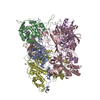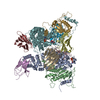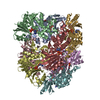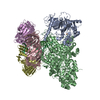[English] 日本語
 Yorodumi
Yorodumi- PDB-7ogp: Structure of the apo-state of the bacteriophage PhiKZ non-virion ... -
+ Open data
Open data
- Basic information
Basic information
| Entry | Database: PDB / ID: 7ogp | |||||||||
|---|---|---|---|---|---|---|---|---|---|---|
| Title | Structure of the apo-state of the bacteriophage PhiKZ non-virion RNA polymerase - class including clamp | |||||||||
 Components Components |
| |||||||||
 Keywords Keywords | TRANSCRIPTION / RNA polymerase / PhiKZ / non-virion | |||||||||
| Function / homology | PHIKZ123 / PHIKZ074 / PHIKZ068 / PHIKZ055 Function and homology information Function and homology information | |||||||||
| Biological species |  Pseudomonas phage phiKZ (virus) Pseudomonas phage phiKZ (virus) | |||||||||
| Method | ELECTRON MICROSCOPY / single particle reconstruction / cryo EM / Resolution: 3.3 Å | |||||||||
 Authors Authors | de Martin Garrido, N. / Lai Wan Loong, Y.T.E. / Yakunina, M. / Aylett, C.H.S. | |||||||||
| Funding support |  United Kingdom, United Kingdom,  Russian Federation, 2items Russian Federation, 2items
| |||||||||
 Citation Citation |  Journal: Nucleic Acids Res / Year: 2021 Journal: Nucleic Acids Res / Year: 2021Title: Structure of the bacteriophage PhiKZ non-virion RNA polymerase. Authors: Natàlia deYMartín Garrido / Mariia Orekhova / Yuen Ting Emilie Lai Wan Loong / Anna Litvinova / Kailash Ramlaul / Tatyana Artamonova / Alexei S Melnikov / Pavel Serdobintsev / Christopher ...Authors: Natàlia deYMartín Garrido / Mariia Orekhova / Yuen Ting Emilie Lai Wan Loong / Anna Litvinova / Kailash Ramlaul / Tatyana Artamonova / Alexei S Melnikov / Pavel Serdobintsev / Christopher H S Aylett / Maria Yakunina /   Abstract: Bacteriophage ΦKZ (PhiKZ) is the archetype of a family of massive bacterial viruses. It is considered to have therapeutic potential as its host, Pseudomonas aeruginosa, is an opportunistic, ...Bacteriophage ΦKZ (PhiKZ) is the archetype of a family of massive bacterial viruses. It is considered to have therapeutic potential as its host, Pseudomonas aeruginosa, is an opportunistic, intrinsically antibiotic resistant, pathogen that kills tens of thousands worldwide each year. ΦKZ is an incredibly interesting virus, expressing many systems that the host already possesses. On infection, it forms a 'nucleus', erecting a barrier around its genome to exclude host endonucleases and CRISPR-Cas systems. ΦKZ infection is independent of the host transcriptional apparatus. It expresses two different multi-subunit RNA polymerases (RNAPs): the virion RNAP (vRNAP) is injected with the viral DNA during infection to transcribe early genes, including those encoding the non-virion RNAP (nvRNAP), which transcribes all further genes. ΦKZ nvRNAP is formed by four polypeptides thought to represent homologues of the eubacterial β/β' subunits, and a fifth with unclear homology, but essential for transcription. We have resolved the structure of ΦKZ nvRNAP to better than 3.0 Å, shedding light on its assembly, homology, and the biological role of the fifth subunit: it is an embedded, integral member of the complex, the position, structural homology and biochemical role of which imply that it has evolved from an ancestral homologue to σ-factor. | |||||||||
| History |
|
- Structure visualization
Structure visualization
| Movie |
 Movie viewer Movie viewer |
|---|---|
| Structure viewer | Molecule:  Molmil Molmil Jmol/JSmol Jmol/JSmol |
- Downloads & links
Downloads & links
- Download
Download
| PDBx/mmCIF format |  7ogp.cif.gz 7ogp.cif.gz | 403.9 KB | Display |  PDBx/mmCIF format PDBx/mmCIF format |
|---|---|---|---|---|
| PDB format |  pdb7ogp.ent.gz pdb7ogp.ent.gz | 314.5 KB | Display |  PDB format PDB format |
| PDBx/mmJSON format |  7ogp.json.gz 7ogp.json.gz | Tree view |  PDBx/mmJSON format PDBx/mmJSON format | |
| Others |  Other downloads Other downloads |
-Validation report
| Summary document |  7ogp_validation.pdf.gz 7ogp_validation.pdf.gz | 1.4 MB | Display |  wwPDB validaton report wwPDB validaton report |
|---|---|---|---|---|
| Full document |  7ogp_full_validation.pdf.gz 7ogp_full_validation.pdf.gz | 1.4 MB | Display | |
| Data in XML |  7ogp_validation.xml.gz 7ogp_validation.xml.gz | 66.3 KB | Display | |
| Data in CIF |  7ogp_validation.cif.gz 7ogp_validation.cif.gz | 99.7 KB | Display | |
| Arichive directory |  https://data.pdbj.org/pub/pdb/validation_reports/og/7ogp https://data.pdbj.org/pub/pdb/validation_reports/og/7ogp ftp://data.pdbj.org/pub/pdb/validation_reports/og/7ogp ftp://data.pdbj.org/pub/pdb/validation_reports/og/7ogp | HTTPS FTP |
-Related structure data
| Related structure data |  12885MC  7ogrC M: map data used to model this data C: citing same article ( |
|---|---|
| Similar structure data | |
| EM raw data |  EMPIAR-10707 (Title: Bacteriophage PhiKZ non-virion RNA Polymerase / Data size: 769.6 EMPIAR-10707 (Title: Bacteriophage PhiKZ non-virion RNA Polymerase / Data size: 769.6 Data #1: PhiKZ non-virion RNA polymerase particles [micrographs - single frame])  EMPIAR-10709 (Title: Bacteriophage PhiKZ non-virion RNA Polymerase / Data size: 3.3 TB EMPIAR-10709 (Title: Bacteriophage PhiKZ non-virion RNA Polymerase / Data size: 3.3 TBData #1: PhiKZ non-virion RNA polymerase particles [micrographs - multiframe]) |
- Links
Links
- Assembly
Assembly
| Deposited unit | 
|
|---|---|
| 1 |
|
- Components
Components
-Protein , 5 types, 5 molecules ABCDE
| #1: Protein | Mass: 57976.605 Da / Num. of mol.: 1 Source method: isolated from a genetically manipulated source Source: (gene. exp.)  Pseudomonas phage phiKZ (virus) / Production host: Pseudomonas phage phiKZ (virus) / Production host:  |
|---|---|
| #2: Protein | Mass: 59419.770 Da / Num. of mol.: 1 Source method: isolated from a genetically manipulated source Source: (gene. exp.)  Pseudomonas phage phiKZ (virus) / Production host: Pseudomonas phage phiKZ (virus) / Production host:  |
| #3: Protein | Mass: 78780.453 Da / Num. of mol.: 1 Source method: isolated from a genetically manipulated source Source: (gene. exp.)  Pseudomonas phage phiKZ (virus) / Production host: Pseudomonas phage phiKZ (virus) / Production host:  |
| #4: Protein | Mass: 77513.461 Da / Num. of mol.: 1 Source method: isolated from a genetically manipulated source Source: (gene. exp.)  Pseudomonas phage phiKZ (virus) / Production host: Pseudomonas phage phiKZ (virus) / Production host:  |
| #5: Protein | Mass: 62959.090 Da / Num. of mol.: 1 Source method: isolated from a genetically manipulated source Source: (gene. exp.)  Pseudomonas phage phiKZ (virus) / Production host: Pseudomonas phage phiKZ (virus) / Production host:  |
-Non-polymers , 1 types, 1 molecules 
| #6: Chemical | ChemComp-ZN / |
|---|
-Details
| Has ligand of interest | N |
|---|
-Experimental details
-Experiment
| Experiment | Method: ELECTRON MICROSCOPY |
|---|---|
| EM experiment | Aggregation state: PARTICLE / 3D reconstruction method: single particle reconstruction |
- Sample preparation
Sample preparation
| Component | Name: Bacteriophage PhiKZ non-virion RNA polymerase / Type: COMPLEX Details: Expressed in E.coli from sequences obtained from the St. Petersburg lab strain of bacteriophage PhiKZ Entity ID: #1-#5 / Source: RECOMBINANT |
|---|---|
| Molecular weight | Value: 0.3 MDa / Experimental value: NO |
| Source (natural) | Organism:  Pseudomonas virus phiKZ / Strain: St. Petersburg Pseudomonas virus phiKZ / Strain: St. Petersburg |
| Source (recombinant) | Organism:  |
| Buffer solution | pH: 8 Details: 15 mM Tris-Cl pH 8.0, 150 mM NaCl, 0.5 mM EDTA, 2 mM MgCl2, 1 mM DTT |
| Specimen | Conc.: 0.3 mg/ml / Embedding applied: NO / Shadowing applied: NO / Staining applied: NO / Vitrification applied: YES |
| Specimen support | Grid type: Quantifoil R2/1 |
| Vitrification | Instrument: FEI VITROBOT MARK IV / Cryogen name: ETHANE / Humidity: 100 % / Chamber temperature: 278 K / Details: 1-2 s blot |
- Electron microscopy imaging
Electron microscopy imaging
| Experimental equipment |  Model: Titan Krios / Image courtesy: FEI Company |
|---|---|
| Microscopy | Model: FEI TITAN KRIOS |
| Electron gun | Electron source:  FIELD EMISSION GUN / Accelerating voltage: 300 kV / Illumination mode: FLOOD BEAM FIELD EMISSION GUN / Accelerating voltage: 300 kV / Illumination mode: FLOOD BEAM |
| Electron lens | Mode: BRIGHT FIELD / Nominal magnification: 48000 X / Nominal defocus max: 3250 nm / Nominal defocus min: 750 nm / Cs: 2.7 mm / C2 aperture diameter: 70 µm / Alignment procedure: COMA FREE |
| Specimen holder | Cryogen: NITROGEN / Specimen holder model: FEI TITAN KRIOS AUTOGRID HOLDER / Temperature (max): 100 K / Temperature (min): 100 K |
| Image recording | Electron dose: 40 e/Å2 / Film or detector model: GATAN K3 BIOQUANTUM (6k x 4k) / Num. of grids imaged: 2 / Num. of real images: 10582 / Details: TIFF movie mode |
| EM imaging optics | Energyfilter name: GIF Bioquantum / Energyfilter slit width: 70 eV |
| Image scans | Sampling size: 5 µm / Width: 5096 / Height: 4092 |
- Processing
Processing
| EM software |
| ||||||||||||||||||||||||||||||||||||||||||||||||||
|---|---|---|---|---|---|---|---|---|---|---|---|---|---|---|---|---|---|---|---|---|---|---|---|---|---|---|---|---|---|---|---|---|---|---|---|---|---|---|---|---|---|---|---|---|---|---|---|---|---|---|---|
| Image processing | Details: Motion correction and dose-weighting in motioncor2 | ||||||||||||||||||||||||||||||||||||||||||||||||||
| CTF correction | Details: During reconstruction in RELION / Type: PHASE FLIPPING AND AMPLITUDE CORRECTION | ||||||||||||||||||||||||||||||||||||||||||||||||||
| Particle selection | Num. of particles selected: 3179799 Details: EMAN BATCHBOXER with low-pass butterworth preprocessing | ||||||||||||||||||||||||||||||||||||||||||||||||||
| 3D reconstruction | Resolution: 3.3 Å / Resolution method: FSC 0.143 CUT-OFF / Num. of particles: 50085 / Symmetry type: POINT | ||||||||||||||||||||||||||||||||||||||||||||||||||
| Atomic model building | Protocol: OTHER Details: Core conserved regions initially identified from comparison with PDB 6EDT - remainder built de novo | ||||||||||||||||||||||||||||||||||||||||||||||||||
| Atomic model building | PDB-ID: 6EDT Accession code: 6EDT / Source name: PDB / Type: experimental model |
 Movie
Movie Controller
Controller











 PDBj
PDBj


